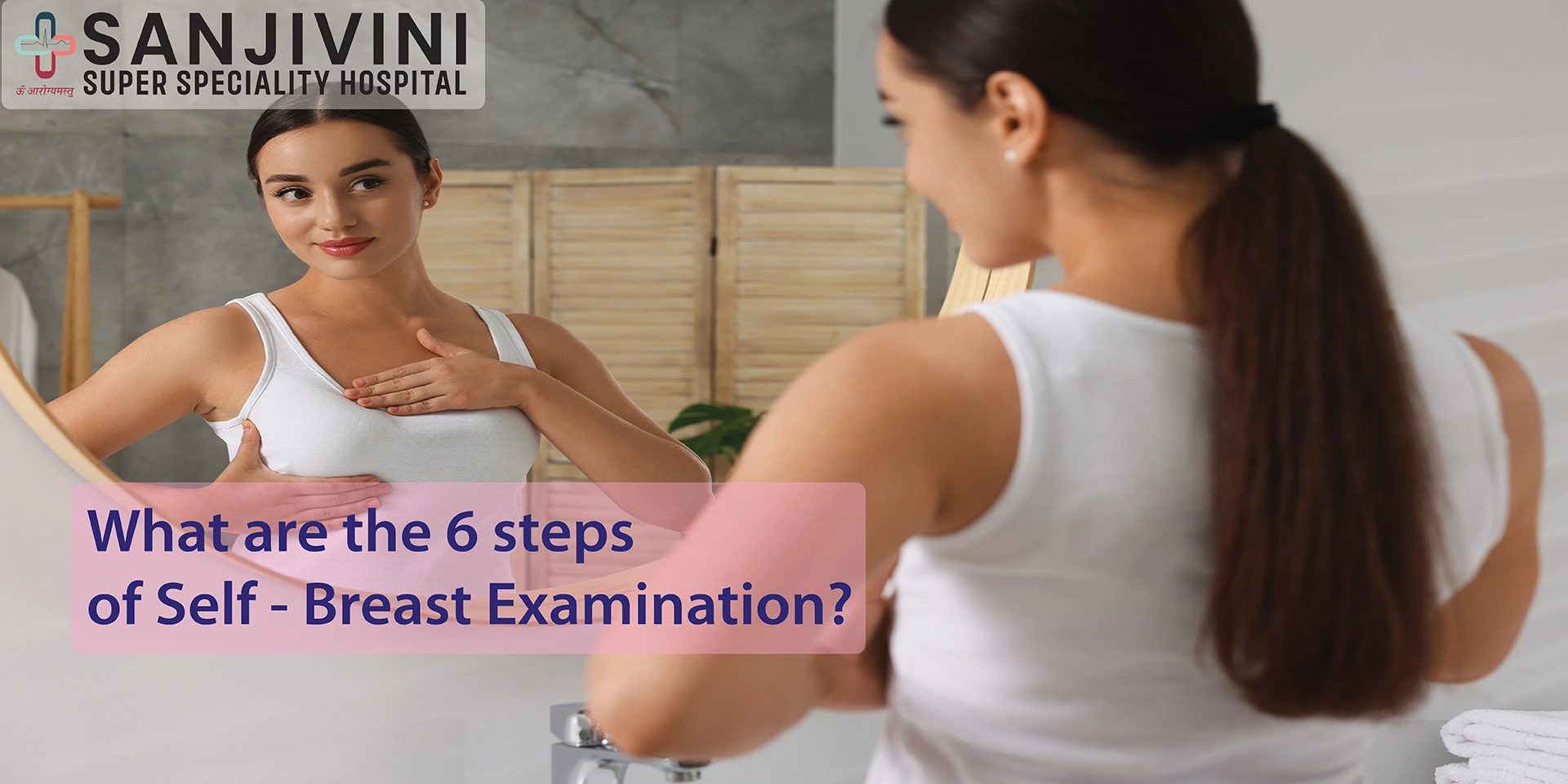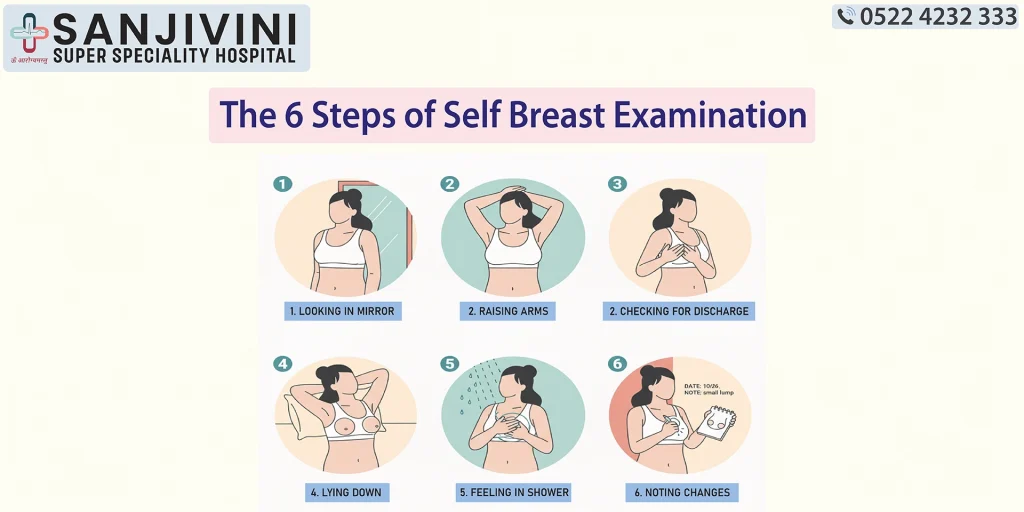
Medically Verified by – Dr Humaira Siddiqui M.B.B.S, M.S (Obs & Gyne)
Early detection of breast cancer can save lives and one of the simplest ways to detect early changes is through a self breast examination. It helps women become familiar with how their breasts normally look and feel, just making it easier to notice any unusual changes.
So, this guide will explain all the six steps of self breast examination, how often to do it, and when to consult a doctor such as a general medicine doctor or gynaecologist for a clinical breast examination.
Why Breast Self-Examination Is Important
Self-breast examination is a quick and effective way for women to become familiar with the normal look and feel of their breasts. Detecting any lump, swelling or skin changes at the early stage allows timely medical evaluation and treatment. A self-examination of breast is not just a replacement for medical screening but a very important part of early detection of breast cancer.
According to the World Health Organization (WHO), breast cancer is the most common cancer among women worldwide. In India, data from the Indian Council of Medical Research (ICMR) shows that breast cancer accounts for nearly 27% of all cancers in women.
When to Perform a Breast Self Examination
Doctors usually recommend that women should perform a self breast examination once every month.
- You may do a few days after your period ends because the breasts are least tender at that time.
- For women who no longer menstruate, they can simply choose a fixed day each month.
- Pregnant or breastfeeding women should first ask their gynaecologist or oncologist for proper guidance.
Regular practice of breast self-examination in India helps women to notice any subtle changes early and seek medical advice without any delay.
6 Steps of Self Breast Examination
Learning how to do a self breast exam at home is super easy. It takes only a few minutes and also requires no special tools. So, here is the correct self breast examination procedure, simplified into six easy steps:

Step 1: Stand in Front of a Mirror
- Stand straight with shoulders back and your arms on your hips.
- Look very closely for any visible changes in the size, shape or colour of your breasts.
- Check if there is any swelling, skin dimpling or a nipple that has changed position.
- This visual inspection is the first step in understanding your normal breast appearance.
Step 2: Raise Your Arms and Look Again
- Now raise your arms above your head and check both breasts in the mirror again.
- See if both breasts move naturally and symmetrically.
- Look for the same signs like any unevenness, colour change or visible lumps.
Step 3: Check for Fluid or Discharge
- While still standing in front of the mirror, gently squeeze each nipple to check for any fluid discharge—whether clear, milky, yellowish, or bloody.
- If you notice anything unusual, then schedule a clinical examination of breast with a qualified doctor immediately.
Step 4: Feel Your Breasts While Lying Down
- Lie down on your back and place a pillow under your right shoulder and your right arm behind your head.
- Using the pads of your left hand fingers, move in small circular motions which will cover the entire breast area from the collarbone to the top of abdomen and from the armpit to cleavage.
- Repeat the same for the other breast too.
- This position will help spread the breast tissues evenly, making it easier to feel for any lumps or thickened areas.
- This is one of the most important self breast examination steps in the procedure.
Step 5: Feel Your Breasts While Standing or Sitting
- Many women prefer to perform this step while in the shower because the wet and soapy skin makes it easier to glide the fingers.
- Cover the entire breast area with the same gentle circular motion with varying pressure — light, medium and firm — to check all parts of your breast and armpit.
- This is part of both the self-examination of breast and physical examination of breast cancer detection at home.
Step 6: Record and Report Any Changes
- Finally, if you notice any new lump, skin dimpling, nipple inversion or discharge, then do not panic because most breast changes are non-cancerous.
- However, you must visit your doctor for a clinical breast examination or imaging tests if needed.
- Keeping a simple record each month helps you notice patterns or differences quickly.
What to Do If You Notice Any Changes
If any lump or persistent discomfort remains for more than two weeks then please visit a gynaecologist or oncologist. At this stage the doctor may recommend you to do:
- Clinical breast examination(visual and manual check by a doctor)
- Ultrasound or mammogram to confirm the findings
- Biopsy only if needed
Never self-diagnose yourself because early medical evaluation will ensure both peace of mind and better outcomes.
Expert Breast Care at Sanjivini Super Speciality Hospital

At Sanjivini Super Speciality Hospital in Lucknow women receive complete and compassionate breast care. The hospital offers clinical breast examinations, diagnostic imaging and consultation from best gynaecologists in Lucknow. Our team finds early detection and accurate diagnosis through following advanced diagnostic protocols:
- Breast examination and imaging
- Mammography and ultrasound facilities
- Oncology and gynaecology consultation
- Counselling and treatment support
- Gynaecology and obstetrics consultation for women’s health and reproductive issues
All services are provided under one roof with personalized medical guidance. You can also explore the wide range of medical facilities and services offered by Sanjivini Super Speciality Hospital to support women’s health.
Frequently Asked Questions
What is self-breast examination?
It is a very simple method for women to check their own breasts for any physical changes like: lumps, swelling or pain.
How often should I perform a breast self-exam?
Perform once every month, ideally you should perform after your menstrual cycle ends. These regular self-checks help you become aware of the normal breast condition.
Is breast self examination effective in India?
Yes. Breast self-examination in India is encouraged by health experts as it promotes both awareness and early detection among women of all age groups.
What is the difference between self and clinical breast examination?
Self-examination is done at home by the woman herself, while a clinical examination of breast cancer signs is performed by a doctor using standardized medical techniques.
What if I feel a lump during self examination?
Do not panic because many lumps are non-cancerous. Visit your gynaecologist or a female doctor in Lucknow at Sanjivini Super Speciality Hospital for further evaluation and tests.
Take Charge of Your Breast Health Today
Practicing self breast examination regularly not only helps in the early detection of breast cancer but also builds body awareness. By practicing all the 6 steps of self-breast examination once a month can really make a life-saving difference.
You can visit Sanjivini Super Speciality Hospital, the best gynaecologisthospital in Lucknow where expert doctors offer breast self examination along with professional care and comprehensive diagnostic support for women’s health. Book your clinical breast examination appointment today to stay one step ahead of breast cancer.
